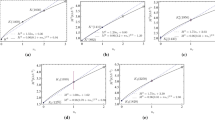Summary
We reexamine a model for spontaneousCP violation and particle-antiparticle asymmetry in which two spinor fields are coupled to two scalar fields through Yukawa couplings. The model has a gauge symmetry and a Higgs potential which, in tree approximation, has a minimum when the vacuum expectation values of the two scalar fields are identical in magnitude but differ by a phase. We show that when one-loop contributions to the effective potential are included, a new nonperturbative vacuum state can appear at a new minimum in which even the magnitudes of the vacuum expectation values of the two scalar fields differ. This second nonperturbative vacuum state manifests spontaneousCP violation due to radiative corrections of the effective potential, a result manifestly different from the consequences of using the tree approximation to the effective potential. In both ground states the model develops two different kinds of domains, in which the particle masses are identical, but the coupling constants in the effective Lagrangians differ. Even when such violations do occur, baryonantibaryon number asymmetries still will not develop unless baryon number violation is initially built into the model. We also note that decay rates for unstable particles are different in the two kinds of domains, even though these total decay rates must be identical for particles and antiparticles in any one domain.
Riassunto
Si riesamina un modello per la violazione diCP spontanea e l’asimmetria particellaantiparticella in cui due campi spinoriali sono accoppiati a due campi scalari attraverso gli accoppiamenti di Yukawa. Il modello ha una simmetria di gauge e un potenziale di Higgs che, nell’approssimazione ad albero, ha un minimo quando i valori attesi nel vuoto dei due campi scalari sono identici in grandezza ma differiscono di una fase. Si mostra che quando si includono i contributi ad un loop al potenziale efficace, può apparire un nuovo stato del vuoto non perturbativo ad un nuovo minimo in cui anche le grandezze dei valori attesi nel vuoto dei due campi scalari differiscono. Questo secondo stato del vuoto non perturbativo manifesta una violazioneCP spontanea dovuta a correzioni radiative del potenziale efficace, un risultato palesemente diverso dalle conseguenze dell’usare l’approssimazione ad albero al potenziale efficace. In entrambi gli stati fondamentali il modello sviluppa due diversi generi di domini in cui le masse delle particelle sono identiche, ma le costanti di accoppiamento nelle lagrangiane efficaci differiscono. Anche quando si manifestano tali violazioni le asimmetrie del numero di barioni-antibarioni tuttavia non si sviluppano finché la violazione del numero di barioni non sia inizialmente costruita nel modello. Si nota anche che i tassi di decadimento per le particelle instabili sono diverse nei due tipi di domini, benché questi tassi di decadimento totale devono essere identici per particelle e antiparticelle in qualsiasi dominio.
Резюме
Мы заново исследуем модель для спонтанногоCP нарушения и асимметрию «частица-античастица», в которой два спинорных поля связаны с двумя скалярными полями через связь Юкавы. Эта модель обладает калибровочной симметрией и потенциалом Хиггса, который, в превовидном приближении, имеет минимум, когда значения вакуумного ожидания для двух скалярных полей являются идентичиыми по величине, но отличаются по фазе. Мы показываем, что, когда учитываются одно-петельные вклады в эффективный потенциал, может появиться новое непертурбационное вакуумное состояние при новом минумуме, в котором даже абсолютные величины вакуумных ожиданий для двух скалярных полей являются различными. Это второе непертурбационное вакуумное состояние обнаруживает спонтанноеCP нарушение, обусловленное радиационными поправкми к эффективному потенциалу; полученный результат явно отличается от следствий использования древовидного приближения для эффективного потенциала. В обоих случаях для основных состояний предложенная модель приводит к двум различным видам областей, в которых массы частиц, являются одинаковыми, но постоянные связи в эффективных Лагранжианах различаются. Даже когда такие нарушения имеют место, асимметрии числа барионов и антибарионов еще не возникают, до тех пор пока нарушение числа барионов первоначально не встроено в рассматриваемую модель. Мы также отмечаем, что интенсивности распада нестабильных частиц являются различными в этих двух видах областей, даже если полные интенсивности распада в любой из областей должны быть одинаковыми для частиц и античастиц.
Similar content being viewed by others
References
M. Kobayashi andT. Maskawa:Prog. Theor. Phys.,49, 652 (1973); for a recent review seeJ. F. Donoghue, E. Golowich andB. Holstein:Phys. Rep.,131, 319 (1986).
S. Weinberg:Phys. Rev. Lett.,37, 657 (1976);G. C. Branco:Phys. Rev. Lett.,44, 504 (1980).
D. V. Nanopoulous andS. Weinberg:Phys. Rev. D.,20, 2484 (1979);S. Barr, G. Segre andH. Weldon:Phys. Rev. D,20, 2494 (1979).
A. I. Sanda:Phys. Rev. D,23, 2647 (1981);N. G. Deshpande:Phys. Rev. D,23, 2654 (1981).
See, for example,P. Frampton:Gauge Field Theories (W. A. Benjamin Inc., Cal., 1987), p. 330.
R. W. Brown andF. W. Stecker:Phys. Rev. Lett.,43, 315 (1979);G. Senjanovic andF. W. Stecker:Phys. Lett. B,96, 285 (1980).
K. Haller andM. Swanson:Nucl. Phys. B,260, 227 (1985).
S. Coleman andE. Weinberg:Phys. Rev. D,7, 1888 (1973).
S. Coleman:Aspects of Symmetry (Cambridge University Press, 1985), Chapt. 5.
Equation (2.1) corrects a typographical error in eq. (2.2) of ref. [1].
C. Itzykson andJ. Zuber:Quantum Field Theory (McGraw-Hill, New York, N.Y., 1980).
J. Iliopoulos, C. Itzykson andA. Martin:Rev. Mod. Phys.,47, 165 (1975);R. H. Brandenberger:Rev. Mod. Phys.,57, 1 (1985).
T. D. Lee:Particle Physics and Introduction to Field Theory (Harwood, Chur, 1981).
G. Luders andB. Zumino:Phys. Rev.,106, 385 (1957).
T. D. Lee:Phys. Rev.,106, 385 (1957), Chapt. 14.
R. F. Streater andA. S. Wightman:PCT, Spin and Statistics and All That (W. A. Benjamin Inc., New York, N.Y., 1964), Chapt. 1.
Author information
Authors and Affiliations
Additional information
To speed up publication, the authors of this paper have agreed to not receive the proofs for correction.
Traduzione a cura della Redazione.
Переведено редакцией.
Rights and permissions
About this article
Cite this article
Haller, K., Swanson, M.S. Radiatively driven breakdown of symmetry and softCP violation. Nuov Cim A 103, 227–254 (1990). https://doi.org/10.1007/BF02820596
Received:
Published:
Issue Date:
DOI: https://doi.org/10.1007/BF02820596




